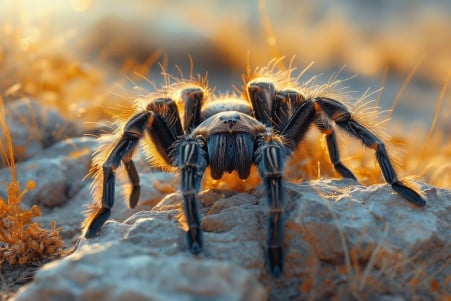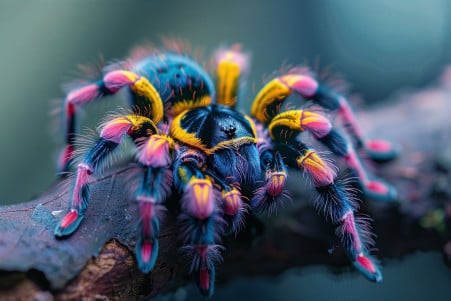Why Do Tarantulas Spin Webs? A Look at Their Silk-Spinning Behaviors
19 February 2024 • Updated 19 February 2024

Tarantulas, the mysterious members of the arachnid family, have a complex relationship with the ancient art of web spinning. While tarantulas do spin silk for a variety of purposes, they do not use their silk to catch prey. Instead, they use it to build shelters, lay eggs, and molt, and they may also use it to stabilize burrows or create trip lines to detect predators.
This article will explore arachnological research and behavioral evidence to better understand the web-spinning behaviors of tarantulas. By investigating the structural biology of these interesting animals and the ecological niches they fill, we will learn more about the complexities of their silk production. Along the way, we will offer a closer look at the many ways tarantulas use their silk and how this behavior fits into their unusual lives.
Why do tarantulas spin webs?
The Sensory World of Tarantula Web Building
The extensive sensory biology of tarantulas is closely tied to their ability to build webs. With a wide range of mechanoreceptors and proprioceptive systems, tarantulas are skilled silk architects.
A study in PMC by Friedrich G. Barth explains that tarantulas’ mechanoreceptors, including trichobothria and slit sensilla, are responsive to mechanical stimuli and are essential to web building and maintenance. These sensory organs allow the spiders to control the amount of silk they produce to ensure the strength and function of their webs.
Of particular interest when it comes to their sensory biology is the tactile hair-sensilla. These hairs give the spider important information as it moves and changes its web. A study in ScienceDirect explains that spiders have a number of different types of sensilla that can sense mechanical, thermal, and chemical stimuli, all of which are likely involved in the complex process of web building.
This work on their sensory biology significantly enhances our knowledge of tarantula silk production and use. It shows the complex relationship between the spiders’ sensory biology and the behaviors it leads to, including web building. Not only does this help us better understand these animals, but it also opens up the possibility of investigating the many ways they may use their silk to meet their needs and goals based on their environment.
Functional Aspects of Tarantula Webs
In addition to prey capture, tarantula webs have a wide range of functions. The specific web types tarantulas create are highly individualized and can be used for a variety of purposes.
For example, terrestrial species like the grammostola rosea tend to create thin “web carpets” in their enclosures that can thicken in the corners or around their hides, according to Tarantula Heaven. Meanwhile, more arboreal species, according to A-Z Animals, may use silk to connect objects in their environment or to line the floors of their retreats, creating a soft place to rest.
Stress, humidity, and nutrition levels, both as environmental and individual variables, can have a major impact on the amount and type of webbing tarantulas do. For example, studies have shown that a tarantula that is well-fed and in a low-stress environment will produce less webbing. Species like the Green Bottle Blue and Avicularia avicularia, for example, create elaborate silk tunnels and hides that are indicative of their multifaceted lifestyles and interactions with their environments.
Knowing the details of tarantulas’ complex webbing behaviors can help us better understand their capabilities and the ecological roles they play. This, in turn, can help us better understand the anatomy that makes such a wide range of silk production possible, a subject that’s full of its own interesting nuances.
The Mystery of Tarantula Silk Production
Tarantulas have a unique physiology that allows them to produce silk, a trait that is typically associated with the presence of spinnerets at the end of the abdomen. These special organs produce silk in most spiders and are essential for web-building.
However, an interesting discussion has arisen about whether tarantulas have other silk-producing mechanisms, especially in their feet. A study in Nature even claims that researchers have seen silk-like fibers coming from nozzle-like structures on tarantula feet, which would mean that tarantulas have an additional way of producing silk to help them stick to vertical surfaces.
However, this claim has been met with doubt. A study in the Journal of Experimental Biology that looked at the same structures on tarantula feet that were originally identified as silk-producing spigots found that they actually look more like chemoreceptors—sensory organs—than silk-secreting ones. The details of these sensory organs, including the unique socket and the bent shaft with fine cuticular ridges, are consistent with the features of chemosensory hairs, not silk spigots.
While the question of whether tarantulas have an additional way of producing silk remains open, the evidence seems to support the traditional idea that the ability to produce silk is primarily associated with spinnerets. However, further research may help to clarify the nature of these structures and their functions, which would add to our knowledge of tarantula biology and the many ways they use silk to survive.
Tarantula Webs as a Part of Nature’s Web of Life
Tarantulas are a highly diverse group of arachnids with a unique ecological niche, that of a burrowing predator. As the National Wildlife Federation notes, their predatory lifestyle is made possible by their silk, which, while not used to capture prey, is used to build and stabilize their habitats and as a trip line to sense the movement of potential prey or threats near their burrows.
The evolutionary flexibility of the tarantula is evident in the many ways their silk is used to support their survival.
The tarantula’s habitat, which ranges from tropical to arid, as noted by National Geographic, impacts their web-building. Silk is used to build burrows, which are a key part of their ecology, and to create a controlled microclimate that’s essential to their survival. In addition, webs are also used in mating, with males using silk to attract females, which is another example of an evolutionary behavioral adaptation.
As Encyclopedia Britannica explains, natural enemies like the parasitic pepsis wasp are a major threat. Webs may help protect tarantulas by allowing them to sense the presence of predators like the parasitic pepsis wasp.
The environmental diversity of tarantulas, which range from the deserts of the Southwest to the tropics of Central and South America, has resulted in a range of web-building behaviors that further demonstrate the importance of silk to their survival. This range of web-building behaviors is another example of the larger story of tarantula adaptability and survival, which is based on an innate understanding of silk.
Evolutionary History: The Evolution of Tarantula Silk
The evolutionary history of silk production in tarantulas is as complex as the webs they spin. As outlined in a review in PubMed, a study by C. L. Craig demonstrated that the ability to produce silk has evolved multiple times in arthropods, with spiders, including tarantulas, developing silk glands through systemic and surficial pathways independently. An onychophoran-like ancestor gave rise to these silk systems, suggesting a deep evolutionary history for this extraordinary proteinaceous biomaterial.
The evolution of silk-secreting systems in response to a variety of selective pressures has shaped the web-building behavior of tarantulas, leading to the diversification of silk usage and the evolution of silk for non-capturing functions, such as stabilizing burrows and mating displays.
In addition, research on supercontraction by Cecilia Boutry, as described in PubMed, demonstrated that while supercontraction is a common property of many spiders’ silks, it is rare in tarantulas, perhaps due to their adaptations to their specific environmental and ecological niches.
Silk genes have been central to the evolution of tarantula silk proteins, and have shaped the properties of the material and the spiders’ web-building behavior. These evolutionary insights help to illustrate the resilience and adaptability of tarantulas, which have allowed them to survive in a range of habitats. The unique properties of their silk also demonstrate this resilience, making tarantulas an evolutionary wonder.
The Many Uses of Tarantula Silk
The many uses of tarantula silk are a demonstration of its complexity and the numerous ways in which it can be used. Unlike other spider silks, which are specialized for prey capture, tarantula silk has evolved to meet a variety of needs, from stabilizing burrows to aiding in reproduction.
A paper in Advanced Science explains that spider silk in general has exceptional tensile strength, toughness, and humidity and water responsiveness, which makes it a prime candidate for biomimetic inspiration in the development of artificial fibers.
However, the material properties of tarantula silk are different from other spider silks, including the well-known dragline silk, which has crystalline regions that contribute to its strength and toughness. An article in Nature Communications argues that it is important to understand the structural properties of spider silk, including tarantula silk, in order to reproduce its mechanical properties in synthetic fibers.
The potential uses of tarantula silk are many, ranging from medical sutures to strong, lightweight materials for aerospace and construction.
The biocompatibility and thermal properties of tarantula silk could have a wide range of applications in technology and medicine.
However, there are many hurdles to overcome before these applications can be realized. A paper in Nature Communications explains that one of the main challenges facing researchers is the difficulty of replicating the complex molecular structure of silk in the lab. Future research will focus on enhancing the spinning and synthesis of silk proteins to achieve the right balance of elasticity, strength, and toughness found in tarantula silk.
Bringing It All Together
In the complex world of arachnids, tarantulas stand out for their idiosyncratic silk-making behaviors. Unlike other spiders, which use their silk to create webs that capture prey, tarantulas use their silk for a variety of non-predatory purposes, from making comfortable homes to laying the foundation for mating. This review has demonstrated that tarantula silk-making is shaped by their sensory biology, which in turn influences their silk-making and silk-using behaviors in their environment.
Tarantula silk-making is inextricably linked to their ecological roles as both predators and prey. Tarantulas have evolved to use silk to respond to opportunities and threats in their natural environments. Evolutionary studies have shown that tarantula silk-making has a long history of adaptation and survival, with the unique material properties of their silk enabling it to be used in a variety of ways in different fields.
Understanding tarantula behavior in the context of their silk-making goes beyond scientific interest, it also helps us understand the diversity and adaptability of life. This understanding has implications outside of the scientific community, highlighting the importance of continued research in understanding and protecting the ecological roles of these amazing animals.


